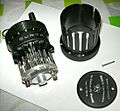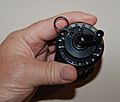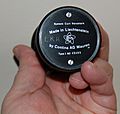Curta calculator facts for kids
The Curta is a small mechanical calculator. It was invented by Curt Herzstark. The Curta was designed to be very small. It looks like a tiny cylinder that fits right in your hand.
People thought Curtas were the best portable calculators. This was true until electronic calculators came out in the 1970s. Even today, the Curta is very popular with collectors. Many old machines still work perfectly.
In 2016, someone designed a Curta that could be made with a 3D printer. However, the parts need to be very precise. Because of this, the 3D-printed version has to be much bigger. It's about the size of a coffee mug.
Contents
What is a Curta?
The Curta calculator works using slides on its side. You use these slides to enter numbers. The top of the calculator shows two things: the revolution counter and the result counter.
When you turn the crank once, the number you entered is added to the result counter. The revolution counter also moves. If you pull the crank up a little before turning it, the machine will subtract instead of add. For more complex math, like multiplying or dividing, you need to turn the crank many times. You also need to shift parts of the calculator.
People sometimes called the Curta the "pepper grinder" or "peppermill." This was because of its shape and how you turn the crank. Some also called it the "math grenade" because it looked a bit like a hand grenade.
Curta Models
There were two main types of Curta calculators:
- Type I Curta: This model lets you enter numbers with eight digits. It has a six-digit revolution counter. The result counter shows eleven digits. It weighs about 245 grams (8.6 oz) (around 8 ounces).
- Type II Curta: This larger model came out in 1954. It has eleven digits for entering numbers. It also has an eight-digit revolution counter and a fifteen-digit result counter. This model weighs about 13.15 ounces (373 g).
About 140,000 Curta calculators were made in total. This includes 80,000 Type I models and 60,000 Type II models. The last Curta was made in 1972.
How Much Did They Cost?
When they were still being made, the Curta Type I sold for about $125. The larger Type II sold for about $175.
Today, these calculators are very special. They can sell for around US$1,000. Some models in perfect condition can even go for as much as US$1,900.
Who Used the Curta?
The Curta was very popular among people who competed in sports car rallies. This was especially true in the 1960s, 1970s, and even into the 1980s. Even after electronic calculators became common, rally drivers still used Curtas. They helped them figure out times and distances. Early electronic calculators sometimes broke down from the bumps and jolts of rally racing. The Curta was much tougher.
People who used Curtas in rallies were sometimes called "Curta-crankers." This was a nickname given by those who used only paper and pencil.
Pilots also liked the Curta calculator. Both commercial and private pilots used them before electronic calculators existed. They liked the Curta because it was very accurate. Pilots could also easily check their work. Calculations like weight and balance are very important for safe flights. So, getting precise results without mistakes was essential.
Images for kids
See also
 In Spanish: Curta para niños
In Spanish: Curta para niños








